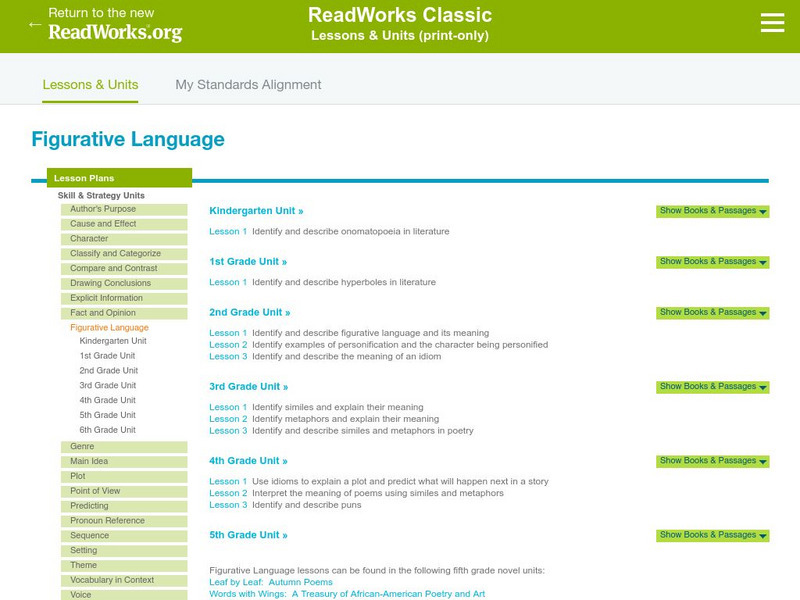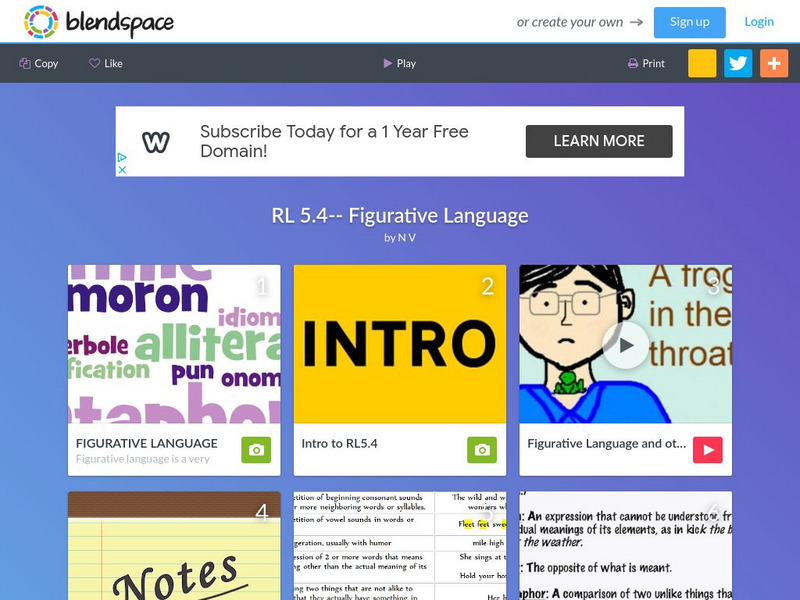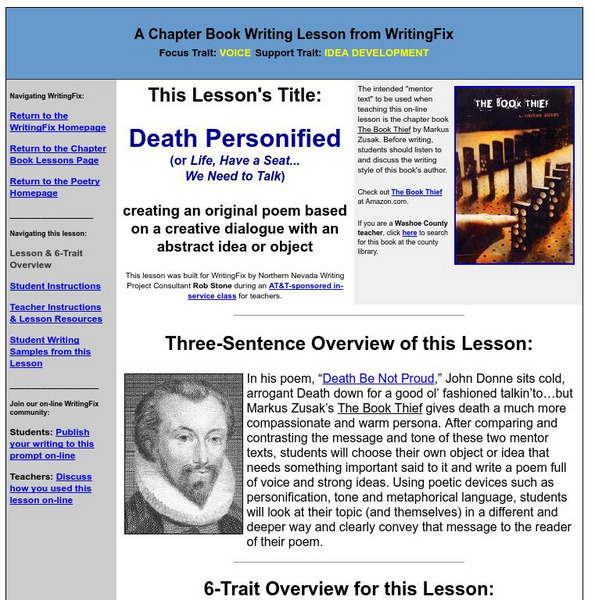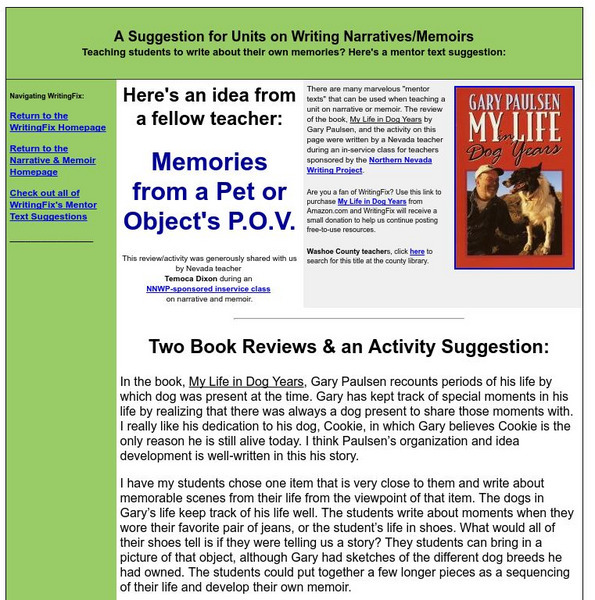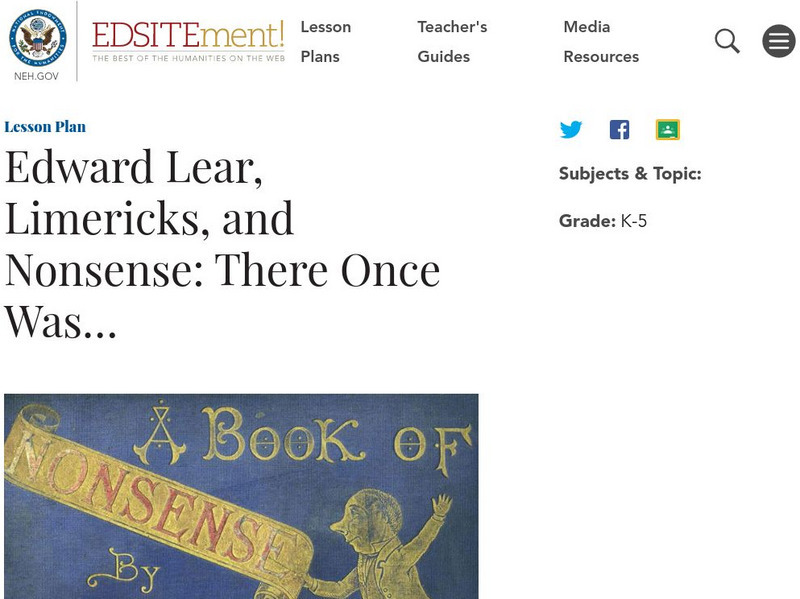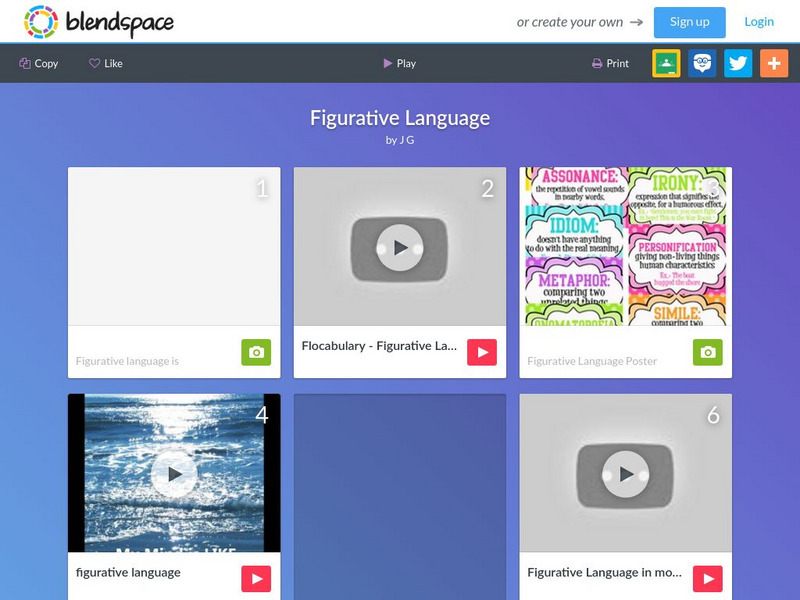Hi, what do you want to do?
PBS
Wnet: Thirteen: I Have a Metaphor
This lesson not only examines the message of Dr. King, but also the words themselves. This is a lesson in identifying the literary devices that he used in his "I Have a Dream" Speech. It will introduce the following literary devices:...
National Endowment for the Humanities
Neh: Edsit Ement: Carl Sandburg's "Chicago": Bringing a Great City Alive
In this lesson students examine primary source documents including photographs, film, maps, and essays to learn about Chicago at the turn of the 20th century and Carl Sandburg's famous poem. After examining the poem's use of...
Read Works
Read Works: Figurative Language
[Free Registration/Login Required] This site contains a collection of passage that include figurative language lessons. Each lesson includes questions to assess student understanding.
TES Global
Blendspace: Rl 5.4 Figurative Language
This twelve-part learning module provides assorted references for figurative language terms. This blendspace provides reproducible charts, flash cards, a game, video tutorial lessons, and rap songs. L.9-10.5 Fig Lang/nuances
Writing Fix
Writing Fix: My Adidas: Letting Your Possessions Tell Your Story
In this lesson plan, students will listen to Run D.M.C.'s classic, "My Adidas", then they will think about everywhere their shoes have taken them and the story they have to tell. Using literary devices such as personification, point of...
Writing Fix
Writing Fix: Personified Number Stories
In this lesson, A Tree Grows in Brooklyn by Betty Smith is used as the mentor text. Students will explore numbers and the properties of these numbers. Students will then write a math story, using the explored numbers, and incorporate...
Lumen Learning
Lumen: Boundless Communications: Deploying Style Effectively
This lesson plan focuses on rhetorical devices and how to use them effectively in public speaking. These include alliteration, antithesis, hyperbole, onomatopoeia, personification, repetition and parallelism, and simile and metaphor.
Alabama Learning Exchange
Alex: The Very Quiet Cricket
During this lesson, students will write a sequel to The Very Quiet Cricket. The students will discuss and demonstrate the use of personification in the story. The class will also complete a WebQuest about The Very Quiet Cricket.
Writing Fix
Writing Fix: Death Personified
In this lesson, students will personify an object within a poem. They will focus on voice and word choice in order to fully convey their message.
E Reading Worksheets
E Reading Worksheets: Figurative Language Activities
Numerous activities, games, quizzes, lessons, and PowerPoint presentations are provided for the topic of "figurative language" in writing. Students will have numerous exposures to examples. Students will also be able to practice...
TES Global
Blendspace: Figurative Language
A forty-six part learning module including links to informational texts, videos, pictures, practice exercises and more on various types of figurative language such as simile, metaphor, personification, idiom, alliteration, hyperbole, and...
TES Global
Blendspace: Gallagher Figurative Language
A learning module with thirty-one links to images, texts, websites, and videos to on figurative language including simile, metaphor, personification, idiom, alliteration, hyperbole, and onomatopoeia.
TES Global
Blendspace: Literary Devices
A learning module with eighteen links to videos and images to use when learning about literary devices including simile, metaphor, personification, onomatopoeia, hyperbole, and alliteration.
Writing Fix
Writing Fix: Suggestions for Writing Memoirs: Memories of a Pet or Object
This lesson, inspired by Gary Paulsen's My Life in Dog Years, helps students write memoirs or narratives about their lives through the eyes of a pet, a favorite pair of jeans, or their shoes. Students choose one item that is very close...
Texas Education Agency
Texas Gateway: Literary Nonfiction
[Accessible by TX Educators. Free Registration/Login Required] In this lesson, you will learn how to analyze literary nonfiction, especially speeches, by making inferences and drawing conclusions based on evidence in the text. The...
National Endowment for the Humanities
Neh: Edsit Ement: There Once Was...
Part 2 of this tutorial on limerick writing demonstrates the importance of form (meter and rhyme) in limerick poetry using the exemplary and amusing work of Edward Lear.
TES Global
Blendspace: Figurative Language
A twelve-part learning module on figurative language including links to images, videos, a song, and a game to help students learn.
TES Global
Blendspace: Figurative Language & Tone
A twelve-part learning module with links to texts, videos, and websites on figurative language and tone.
South Carolina Educational Television
Know It All: Using Figurative Language to Shape Meaning and Style
The students will be able to identify different types of figurative language in a story and explain how the author uses figurative language to shape the meaning and style of the story.
Louisiana Department of Education
Louisiana Doe: Curriculum Hub: Ela Guidebooks: Romeo and Juliet: Sentence Structure
Students analyze the structure of a sentence from the prologue of Act II of Romeo and Juliet to determine how understanding the sentence deepens our understanding of the text.







